Because speed, flexibility, and sanity still matter
Traditional CPQ systems promise to streamline sales processes but often create more complexity than they solve. No-code CPQ platforms are revolutionizing the configure-price-quote landscape by putting control back in the hands of business users, reducing deployment times from months to weeks, and eliminating costly IT dependencies. While legacy systems require extensive developer support and lengthy implementation cycles, modern no-code solutions deliver enterprise-grade functionality through intuitive interfaces that sales teams can actually use. The shift represents more than just technological evolution—it’s a fundamental reimagining of how businesses approach sales automation and revenue optimization.
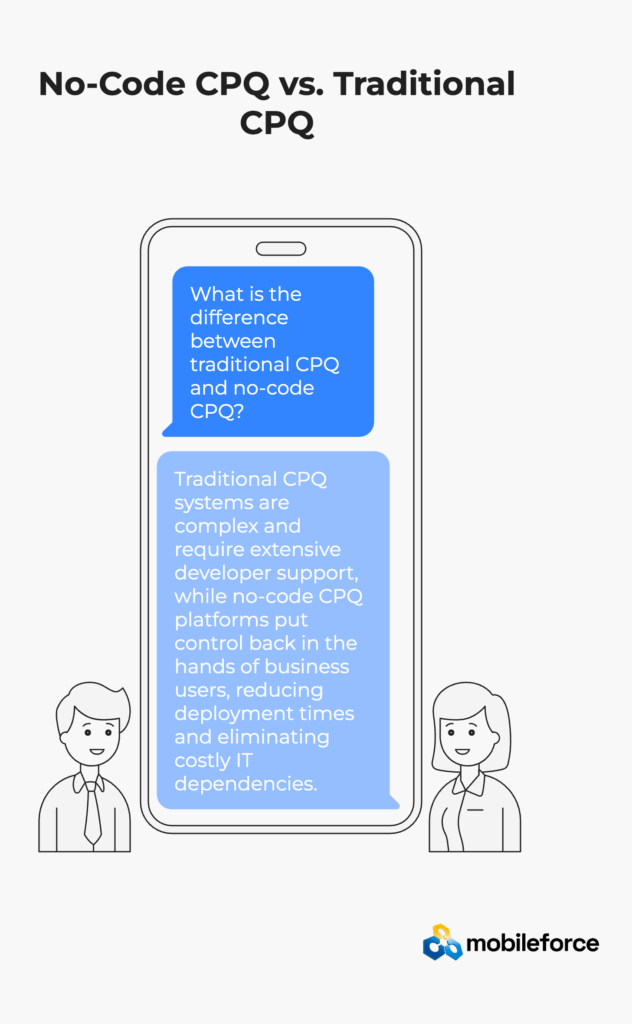
Configure price quote software comparison reveals significant differences between legacy platforms and modern no-code alternatives. Sales teams using automated quoting systems report improved sales productivity, faster deal closure rates, and enhanced customer experience through streamlined proposal generation.
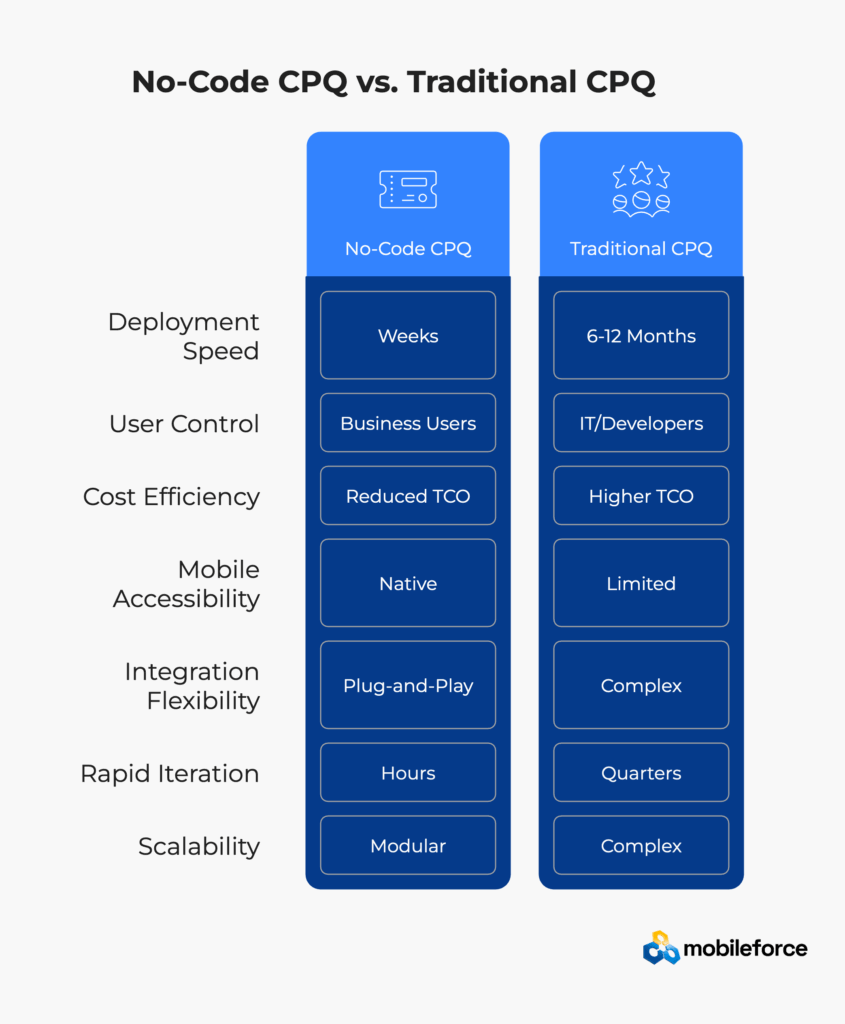
“We bought a CPQ system to make quoting faster, but now it takes our IT team three weeks to add a new product bundle.” This sentiment, shared by a sales operations manager at a mid-sized manufacturing company, captures the fundamental irony plaguing today’s sales technology landscape.
Configure-Price-Quote systems were supposed to be the great equalizer for complex B2B sales. They promised to transform the chaotic process of manual quoting into a streamlined, automated workflow that would accelerate deal velocity and improve quote accuracy. Instead, many organizations find themselves trapped in a web of customizations, dependencies, and technical debt that slows down the very processes they intended to optimize.
The challenge isn’t with the concept of CPQ itself—automating product configuration, pricing calculations, and quote generation remains a critical business need for sales organizations dealing with complex product catalogs and multi-tier pricing structures. Rather, the problem lies in how traditional CPQ platforms approach these challenges. Built on legacy architectures that prioritize depth over agility, these systems often require armies of developers, months-long implementation cycles, and ongoing IT support that can consume significant portions of a company’s technology budget.
But there’s a revolution brewing in the sales technology space. No-code CPQ platforms are fundamentally changing the equation by democratizing the configuration process and putting control back where it belongs: in the hands of the business users who understand products, pricing strategies, and customer needs better than anyone else.
Sales automation tools have evolved beyond simple quote generators to become comprehensive revenue optimization platforms that support guided selling, dynamic pricing, and intelligent product recommendations throughout the sales cycle.
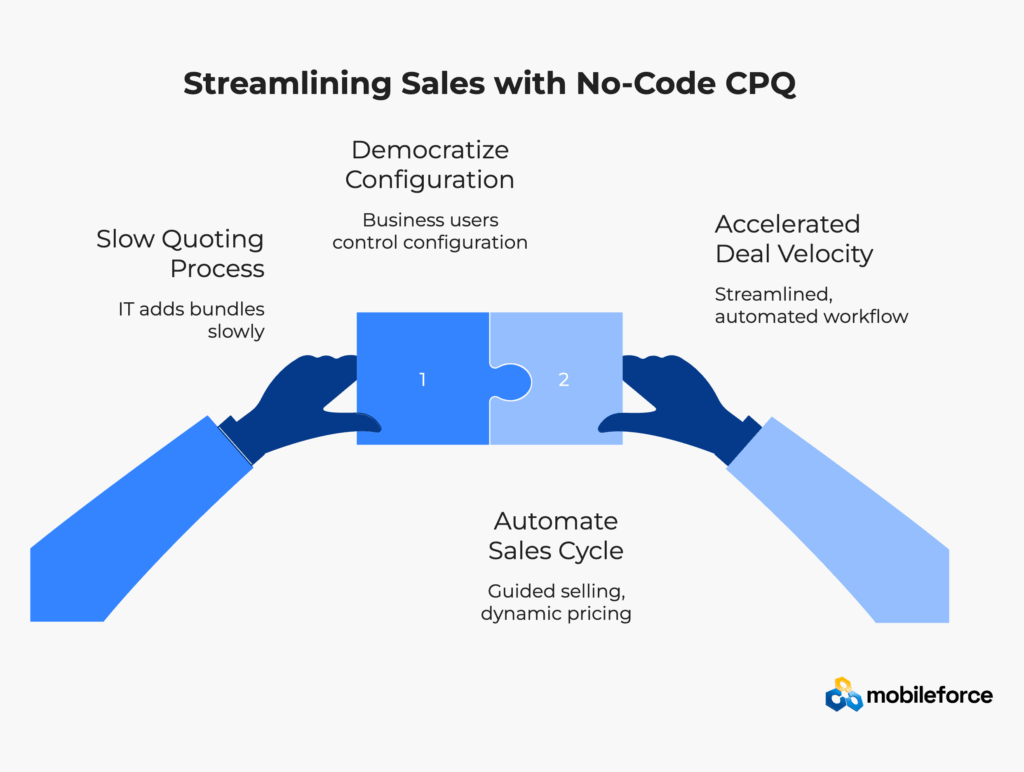
Traditional CPQ systems emerged during an era when software customization required deep technical expertise and lengthy development cycles were simply accepted as the cost of doing business. These platforms, often built as extensions of existing CRM ecosystems or as standalone enterprise applications, follow a philosophy that prioritizes comprehensive functionality over user accessibility.
The architecture of traditional CPQ typically involves complex database schemas, rigid workflow engines, and configuration tools that require specialized knowledge to operate effectively. When a sales manager wants to update pricing for a seasonal promotion or add a new product variant, the request often flows through a formal IT ticket system, gets prioritized against other development work, and may take weeks or months to implement.
According to the latest research from Gartner’s 2025 Magic Quadrant for CPQ Applications, which evaluates the most significant CPQ vendors in the market, traditional enterprise CPQ implementations continue to take between 8-14 months and require ongoing technical support that can cost $100,000-$300,000 annually for mid-market companies. This creates a fundamental disconnect between the pace of business change and the platform’s ability to adapt.
Consider the experience of companies trying to respond to market disruptions. During the COVID-19 pandemic, many manufacturers needed to quickly adjust pricing models, introduce new service bundles, and modify standard terms and conditions. Organizations running traditional CPQ systems often found themselves constrained by their technology rather than empowered by it. Simple changes that should have taken hours stretched into weeks because every modification required developer intervention.
The integration challenges are equally problematic. Traditional systems often work well within their native ecosystems but struggle when businesses need to connect with best-of-breed solutions across different functional areas. A company using Salesforce for CRM but Microsoft Dynamics for ERP might find that their CPQ system creates data silos rather than bridging them effectively.
Enterprise CPQ software designed for complex sales environments must support advanced product configurators, sophisticated pricing engines, and seamless CRM integration while maintaining the flexibility to adapt to changing business requirements. Quote-to-cash automation becomes increasingly critical as organizations scale their sales operations across multiple channels and geographic regions.
Sales configurator tools within traditional platforms often require extensive customization to handle industry-specific requirements, leading to prolonged implementation timelines and increased total cost of ownership for organizations seeking efficient quoting solutions.
Ready to experience the difference that user-friendly CPQ can make? Schedule a demo to see how modern platforms eliminate traditional bottlenecks and put control back in your hands.
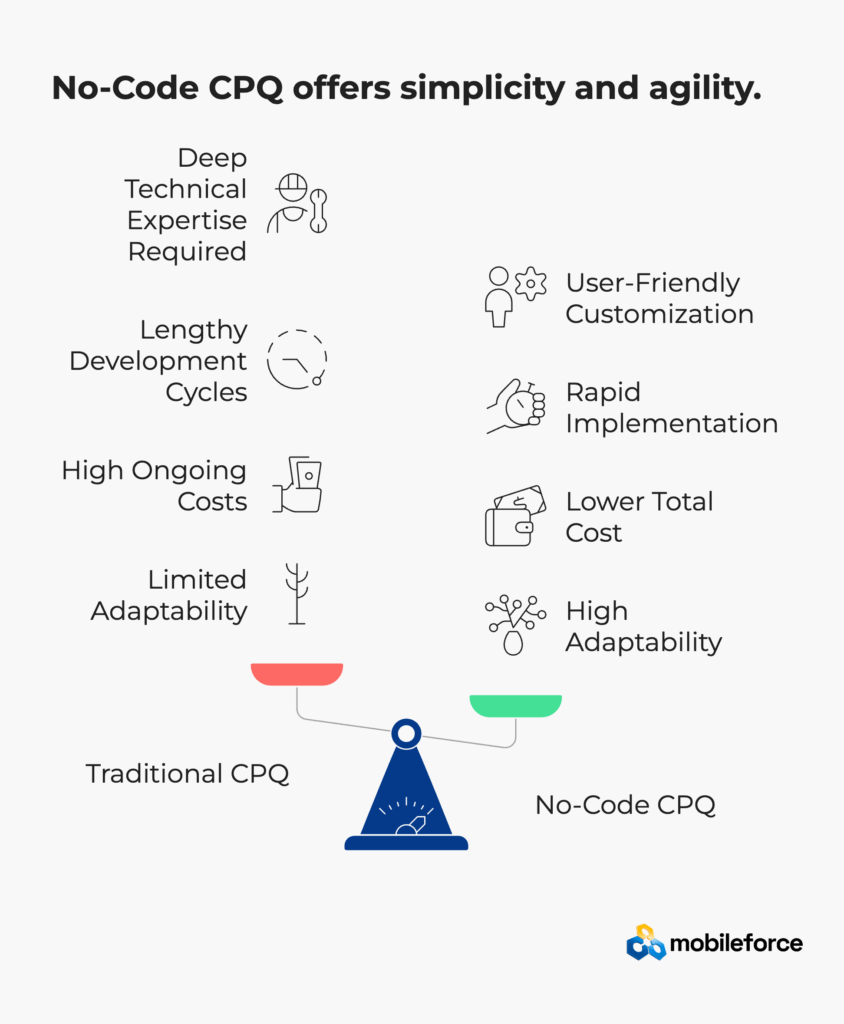
No-code CPQ represents a fundamental shift in how sales technology is conceived, built, and deployed. Rather than treating configuration as a technical exercise requiring specialized expertise, these platforms embrace visual design principles that make complex logic accessible to business users.
The core philosophy behind no-code CPQ centers on the idea that the people closest to the business problem should have the tools to solve it directly. Sales operations managers understand product relationships, pricing strategies, and approval workflows better than IT developers—so why shouldn’t they be able to implement these rules themselves?
Modern no-code platforms achieve this through sophisticated abstraction layers that translate business logic into executable code without requiring users to write a single line of programming. Drag-and-drop interfaces replace complex scripting languages. Visual workflow designers eliminate the need for technical documentation. Pre-built connector libraries enable integrations that previously required custom development.
The speed advantage is immediately apparent. While traditional CPQ implementations follow waterfall methodologies with extensive requirements gathering, design phases, and testing cycles, no-code platforms enable iterative deployment where initial configurations can be live within days and refined continuously based on user feedback.
But speed isn’t the only advantage. No-code platforms also provide transparency that traditional systems often lack. Business users can see exactly how pricing rules work, understand approval workflows, and modify configurations with confidence because the logic is expressed visually rather than buried in code comments and technical documentation.
Research from Forrester’s Low-Code Platforms Wave indicates that organizations using no-code platforms for sales automation see 73% faster time-to-value compared to traditional approaches, with 89% reporting improved agility in responding to market changes. According to the study, 87% of enterprise developers now use low-code development platforms for building applications, with the U.S. low-code market expected to grow at a CAGR of 19.20% through 2033.
Low-code CPQ platforms enable citizen developers within sales organizations to build and modify automated quoting systems without traditional programming skills. These visual development environments support rapid prototyping and iteration while maintaining enterprise-grade security and governance controls.
CPQ automation benefits extend beyond simple quote generation to include comprehensive sales process optimization, intelligent product bundling recommendations, and real-time pricing adjustments based on market conditions and customer-specific factors. Sales teams gain access to self-service configuration capabilities that reduce dependency on IT resources while accelerating response times to customer inquiries.
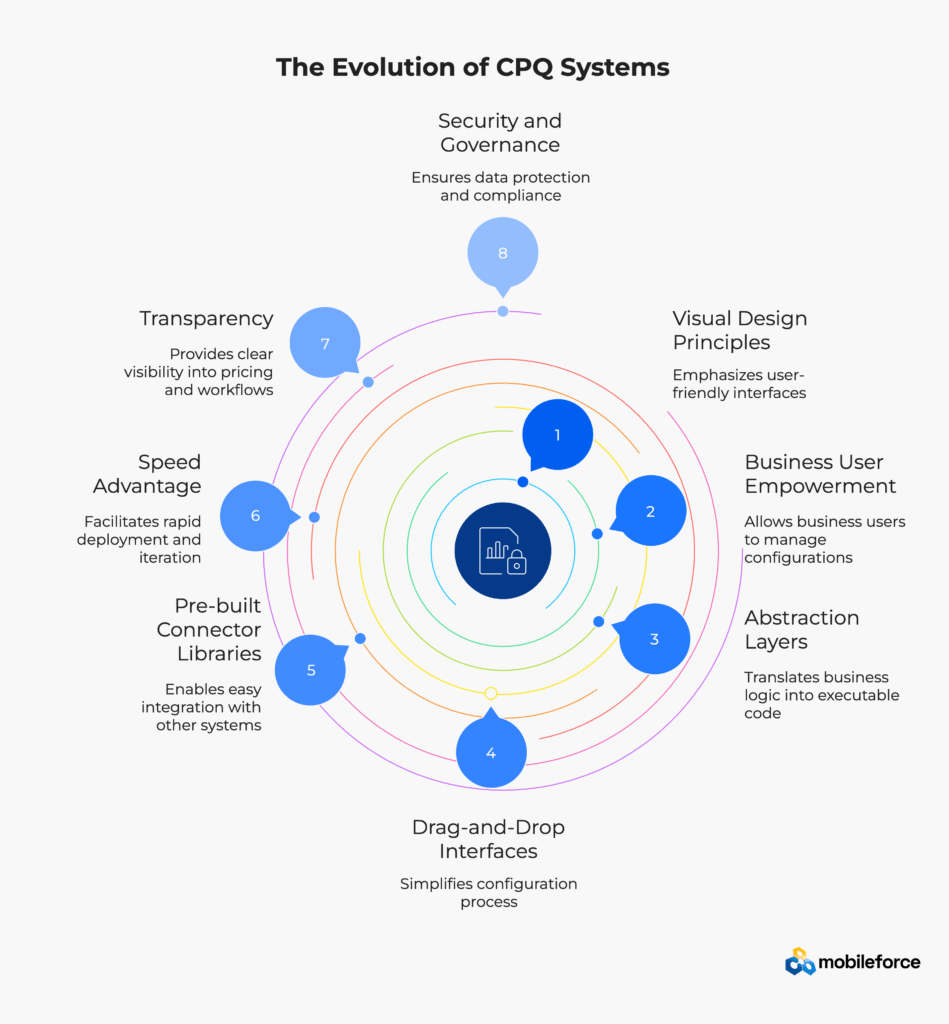
Capability | Traditional CPQ | No-Code CPQ |
Initial Deployment | 6-12 months average | 2-6 weeks typical |
Configuration Changes | Requires developer resources | Business user self-service |
Ongoing Maintenance | $100K-$300K annually | Minimal IT overhead |
Integration Complexity | Custom coding required | Pre-built connectors |
Mobile Optimization | Often limited or afterthought | Native mobile-first design |
User Training | Extensive technical training | Intuitive interface learning |
Customization Depth | Unlimited but expensive | Comprehensive within framework |
Scalability Model | Linear cost increases | Modular expansion |
The deployment timeline difference alone represents a competitive advantage that can’t be ignored. In industries where product lifecycles are measured in months rather than years, the ability to bring CPQ capabilities online quickly can mean the difference between capturing market opportunities and missing them entirely.
Configuration agility presents an even more compelling case for no-code approaches. Traditional systems create what software architects call “technical debt”—accumulated complexity that makes future changes progressively more difficult and expensive. Each customization builds upon previous modifications, creating intricate dependencies that require expert knowledge to navigate safely.
No-code platforms avoid this trap by maintaining clear separation between business logic and underlying system architecture. Changes to pricing rules, product configurations, or approval workflows happen at the business layer without affecting core platform stability. This means organizations can experiment with new approaches, test market responses, and iterate quickly without fear of breaking existing functionality.
CPQ software comparison studies consistently show that modern cloud-based solutions offer superior user experience and faster implementation compared to legacy on-premise systems. Best CPQ software platforms provide comprehensive product catalog management, advanced pricing engines, and seamless integration with popular CRM platforms.
Sales teams seeking efficient proposal generation tools benefit from CPQ solutions that offer automated document creation, electronic signature integration, and real-time collaboration features. The quote-to-cash process becomes streamlined when organizations implement CPQ systems designed for rapid deployment and ongoing business user management.
Digital selling platforms increasingly incorporate AI-powered features such as intelligent product recommendations, dynamic pricing optimization, and predictive analytics to enhance sales effectiveness and improve customer engagement throughout the buying journey.

The business case for no-code CPQ extends far beyond implementation speed and cost savings. Organizations that make the transition often discover benefits they didn’t anticipate when evaluating different approaches.
Quote generation time represents the most immediate and measurable improvement. Traditional CPQ systems, despite their automation promises, often still require multiple steps, system handoffs, and manual reviews that can stretch the quoting process across several days. No-code platforms, with their streamlined workflows and integrated approval processes, can reduce quote generation time from days to minutes for standard configurations.
A study by Aberdeen Group found that companies using modern CPQ solutions generate quotes 68% faster than those relying on manual processes or legacy systems. More importantly, Aberdeen’s research shows that Best-in-Class CPQ users achieve 5 times greater year-over-year revenue growth compared to their peers (15.7% vs 2.6%), while also seeing 4.8 times greater annual increases in profit margins. But the speed improvement is just the beginning.
Pricing accuracy improves dramatically when business users can directly implement and test pricing rules. Traditional systems often suffer from the “telephone game” effect, where business requirements get translated through multiple layers of technical interpretation before becoming functional code. Each translation step introduces potential for errors or misalignment with business intent.
No-code platforms eliminate these translation layers. When a pricing manager creates a volume discount rule, they’re directly implementing their business logic rather than describing it to someone else who will interpret and code it. This direct connection between intent and implementation significantly reduces pricing errors and improves quote accuracy.
The democratization of configuration also accelerates organizational learning. When business users can quickly test new pricing strategies, bundle configurations, or approval workflows, they gather market feedback faster and make data-driven improvements more frequently. This creates a continuous improvement cycle that’s difficult to achieve with traditional systems where each change requires formal project planning and resource allocation.
Curious about how these benefits translate to real business outcomes? Book a consultation to explore specific use cases tailored to your industry and see how no-code CPQ can transform your sales processes.
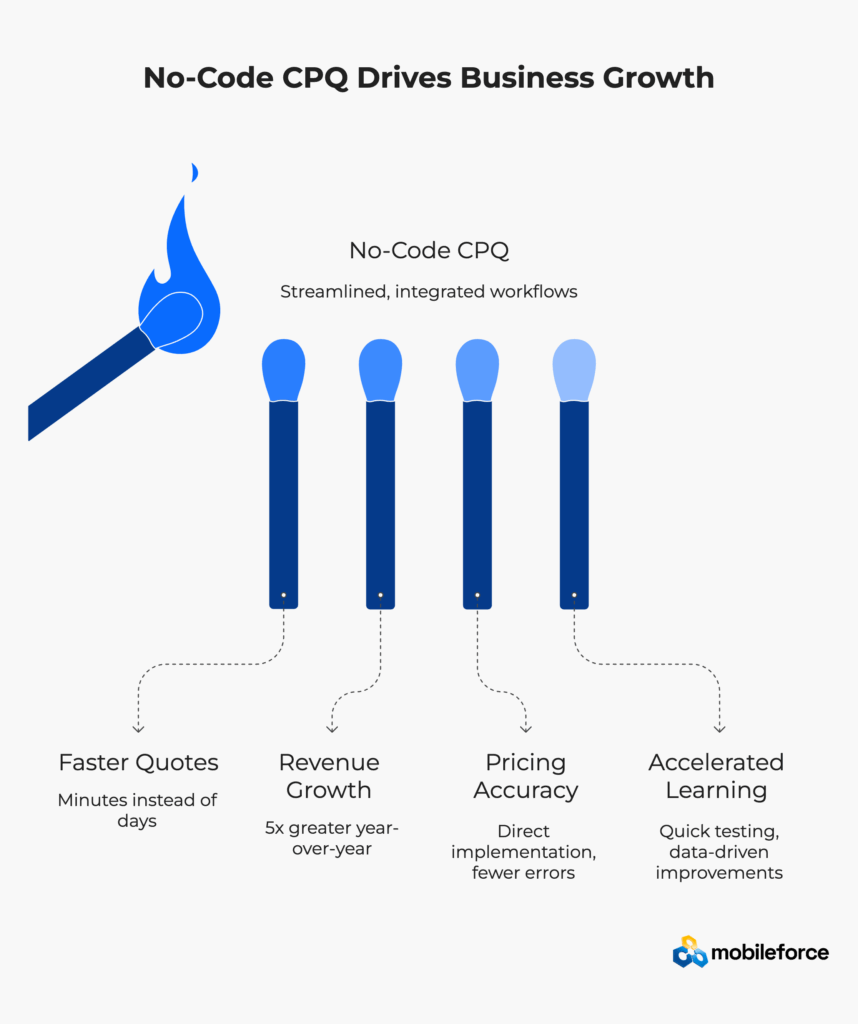
Despite clear advantages, some organizations remain hesitant to embrace no-code CPQ due to lingering misconceptions about platform capabilities and limitations. These concerns, while understandable given past experiences with simplified tools, often don’t reflect the sophistication of modern no-code platforms.
The most common objection centers on customization capabilities. Decision-makers worry that no-code platforms won’t support their unique business requirements or complex product configurations. This concern typically stems from experience with early-generation automation tools that prioritized simplicity over functionality.
Modern no-code CPQ platforms address this through sophisticated rule engines and logic libraries that can handle complex scenarios without requiring traditional coding. Advanced conditional logic, multi-variable pricing models, and intricate approval workflows are all possible within no-code frameworks. The key difference is that these capabilities are accessed through visual interfaces rather than programming languages.
For organizations with truly unique requirements that exceed standard platform capabilities, most enterprise no-code platforms provide escape hatches—controlled ways to add custom functionality without compromising the overall no-code approach. This hybrid model enables organizations to benefit from no-code simplicity while maintaining access to custom development when absolutely necessary.
Scalability concerns often reflect assumptions about no-code platforms being suitable only for simple use cases or small organizations. In reality, many enterprise-grade no-code CPQ platforms support thousands of users, millions of product configurations, and complex multi-entity organizational structures.
According to industry analysis, the scalability advantage actually often favors no-code approaches because they avoid the architectural complexity that can create performance bottlenecks in traditional systems. When business logic is implemented through declarative rules rather than procedural code, platforms can optimize execution more effectively and scale resources dynamically based on demand.
Enterprise buyers frequently express concerns about security and governance in no-code environments. The fear is that democratizing configuration capabilities will lead to unauthorized changes, security vulnerabilities, or compliance violations.
Professional no-code platforms address these concerns through comprehensive role-based access controls, audit trails, and approval workflows. Business users gain the ability to make authorized changes within their areas of responsibility, but the platform maintains complete visibility into who made what changes and when. Many platforms provide more detailed governance capabilities than traditional systems because all changes flow through controlled interfaces rather than direct database modifications or custom code deployments.
Enterprise CPQ solutions must demonstrate robust security frameworks and compliance capabilities to meet stringent organizational requirements. Modern cloud-based CPQ platforms implement multi-layered security controls that often exceed the capabilities of legacy on-premise alternatives.
Sales process automation tools require careful governance to ensure pricing integrity and maintain compliance with corporate policies. No-code platforms enable business users to implement changes while maintaining audit trails and approval workflows that satisfy enterprise governance requirements.

Industry analysis reveals consistent patterns in how traditional CPQ vendors struggle to address modern business requirements. These limitations aren’t necessarily flaws in individual products but rather natural consequences of architectural choices made years or decades ago.
Salesforce CPQ, while deeply integrated with the Salesforce ecosystem, requires significant technical expertise to implement and maintain effectively. According to reviews on G2’s 2025 CPQ Software rankings, users consistently cite complexity as a major challenge, with average implementation times exceeding 8 months for mid-market deployments. The platform’s power comes at the cost of accessibility, often requiring dedicated Salesforce developers for ongoing maintenance.
Oracle CPQ offers comprehensive functionality but suffers from user interface challenges that reflect its enterprise software heritage. G2 reviewers frequently complain about slow performance and unintuitive workflows that require extensive training to master. The platform excels in large enterprise environments with dedicated IT support but struggles in agile organizations that need rapid iteration.
DealHub and PandaDoc represent newer entrants that focus on user experience improvements but often lack the deep integration capabilities that complex B2B organizations require. While these platforms are easier to use than traditional alternatives, they may not support the sophisticated pricing models, approval workflows, and multi-system integrations that enterprise buyers need.
The common thread across traditional platforms is the trade-off between functionality and accessibility. Vendors typically optimize for either comprehensive capabilities or ease of use, but rarely achieve both effectively within a single platform.
Traditional CPQ vendors often struggle with mobile CPQ capabilities, offering limited functionality for field sales teams who need full-featured quoting tools on mobile devices. Legacy systems frequently require extensive customization to support modern sales processes and buyer expectations for self-service configuration options.
Cloud CPQ solutions from established vendors may offer comprehensive feature sets but often come with complex implementation requirements and ongoing maintenance overhead that can strain IT resources. Sales organizations seeking agile quoting solutions increasingly evaluate CPQ alternatives that prioritize user experience and rapid deployment over extensive customization capabilities.
Enterprise sales teams require CPQ tools that support complex product hierarchies, multi-tier pricing structures, and sophisticated approval workflows without requiring extensive technical expertise to operate and maintain. enterprise buyers need.
The common thread across traditional platforms is the trade-off between functionality and accessibility. Vendors typically optimize for either comprehensive capabilities or ease of use, but rarely achieve both effectively within a single platform.

Mobileforce.ai represents a new generation of CPQ platforms that eliminate the traditional trade-off between power and simplicity. Built from the ground up as a no-code solution, the platform provides enterprise-grade functionality through interfaces that business users can master without extensive technical training.
The platform’s architecture reflects years of learning about what works and what doesn’t in sales automation. Rather than starting with a traditional software framework and adding no-code capabilities as an afterthought, Mobileforce.ai began with user experience requirements and built the underlying technology to support those goals.
One of Mobileforce.ai’s key differentiators is its ability to integrate seamlessly with multiple CRM platforms without requiring users to abandon their existing technology investments. Whether an organization uses Salesforce, HubSpot, Microsoft Dynamics, or NetSuite, the platform provides native integration capabilities that sync data bidirectionally and maintain consistency across systems.
This CRM-agnostic approach addresses a common challenge in the CPQ market where vendors often require organizations to adopt their preferred ecosystem or accept limited integration capabilities. Mobileforce.ai enables organizations to choose best-of-breed solutions across different functional areas while maintaining unified sales processes.
The platform’s mobile-first architecture reflects the reality of modern B2B sales environments where field sales representatives, service technicians, and channel partners need access to CPQ capabilities regardless of location or device. Unlike traditional platforms that treat mobile access as an add-on feature, Mobileforce.ai provides full functionality through native mobile applications that work offline and sync automatically when connectivity is restored.
This mobile emphasis proves particularly valuable for organizations with distributed sales teams, field service operations, or channel partner networks. Sales representatives can generate accurate quotes during customer meetings, service technicians can configure replacement equipment on-site, and channel partners can access real-time pricing without requiring VPN connections or complex security configurations.
Mobileforce.ai incorporates artificial intelligence and machine learning capabilities that help users make better decisions without requiring data science expertise. The platform can suggest optimal product configurations based on customer requirements, recommend pricing strategies that balance competitiveness with profitability, and identify approval bottlenecks that slow deal progression.
These intelligence capabilities work behind the scenes to enhance user productivity rather than replacing human judgment. The platform provides insights and recommendations, but business users retain full control over final decisions and can easily understand how recommendations are generated.
Sales enablement tools within the platform support guided selling methodologies that help sales representatives identify optimal product combinations and pricing strategies for specific customer scenarios. The intelligent quoting system learns from successful deals to improve future recommendations and pricing accuracy.
CPQ implementation success depends on selecting platforms that balance powerful functionality with user-friendly interfaces. Mobileforce.ai delivers enterprise CPQ capabilities through no-code configuration tools that enable rapid deployment and ongoing business user management without extensive IT involvement.
Revenue management features integrated within the platform provide real-time visibility into pricing performance, deal profitability, and sales team effectiveness. These analytics capabilities help organizations optimize their pricing strategies and identify opportunities for revenue growth.
Experience the Mobileforce.ai difference firsthand—schedule your personalized demo to see how modern CPQ eliminates the complexity that holds back traditional systems while delivering enterprise-grade functionality.
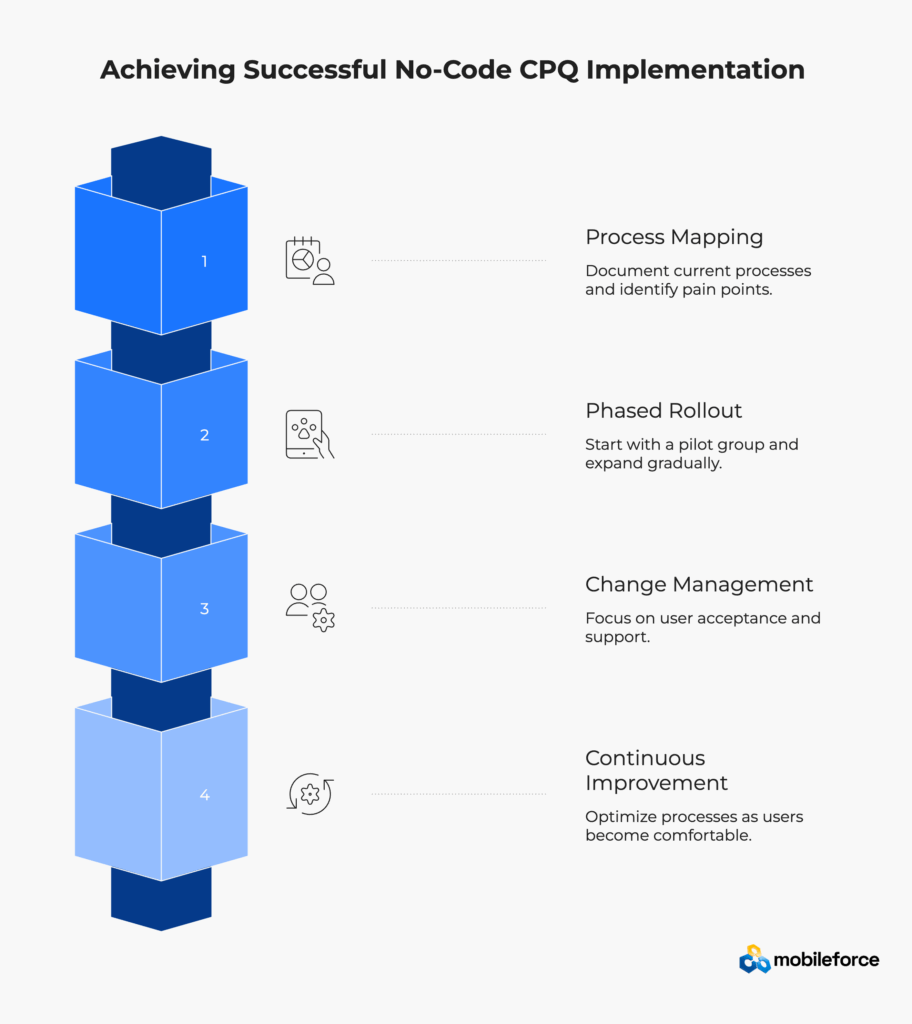
Successful no-code CPQ implementation requires more than just selecting the right platform. Organizations that achieve the best results follow proven methodologies that maximize user adoption while minimizing disruption to ongoing sales activities.
Before configuring any software, successful organizations invest time in documenting their current quoting processes, identifying pain points, and defining success metrics. This process mapping exercise often reveals opportunities for improvement that extend beyond technology implementation.
The goal isn’t to replicate existing manual processes in digital form, but rather to redesign workflows that take advantage of automation capabilities while eliminating unnecessary steps. Many organizations discover that their current processes include workarounds for limitations that no longer apply with modern CPQ platforms.
While no-code platforms enable faster implementation than traditional alternatives, the most successful deployments still follow phased approaches that allow for learning and refinement. Starting with a pilot group of experienced sales representatives provides valuable feedback before expanding to the broader organization.
This phased approach also allows organizations to build internal expertise and develop training materials based on real-world usage patterns. Early adopters often become champions who help drive broader organizational adoption.
Technology adoption ultimately depends on user acceptance, and even the most intuitive no-code platforms require some adjustment for users accustomed to different workflows. Successful implementations invest significantly in change management activities that help users understand not just how to use new tools, but why the changes benefit them personally.
Effective change management for CPQ implementations focuses on demonstrating early wins, providing ongoing support, and celebrating successes that reinforce the value of new approaches. Organizations that treat implementation as purely a technical exercise often struggle with user adoption regardless of platform quality.
CPQ best practices include establishing clear governance policies, training programs, and ongoing support structures that ensure long-term success. Organizations should plan for continuous improvement and optimization as users become more comfortable with the platform capabilities.
Sales process optimization requires careful attention to user experience design and workflow efficiency. The most successful CPQ implementations focus on eliminating friction in the sales process while providing sales teams with the tools they need to be more effective and responsive to customer needs.
Automated sales workflows designed through no-code platforms enable rapid adaptation to changing business requirements without requiring extensive development resources. Sales operations teams can modify processes, update pricing rules, and implement new approval workflows as business conditions evolve.
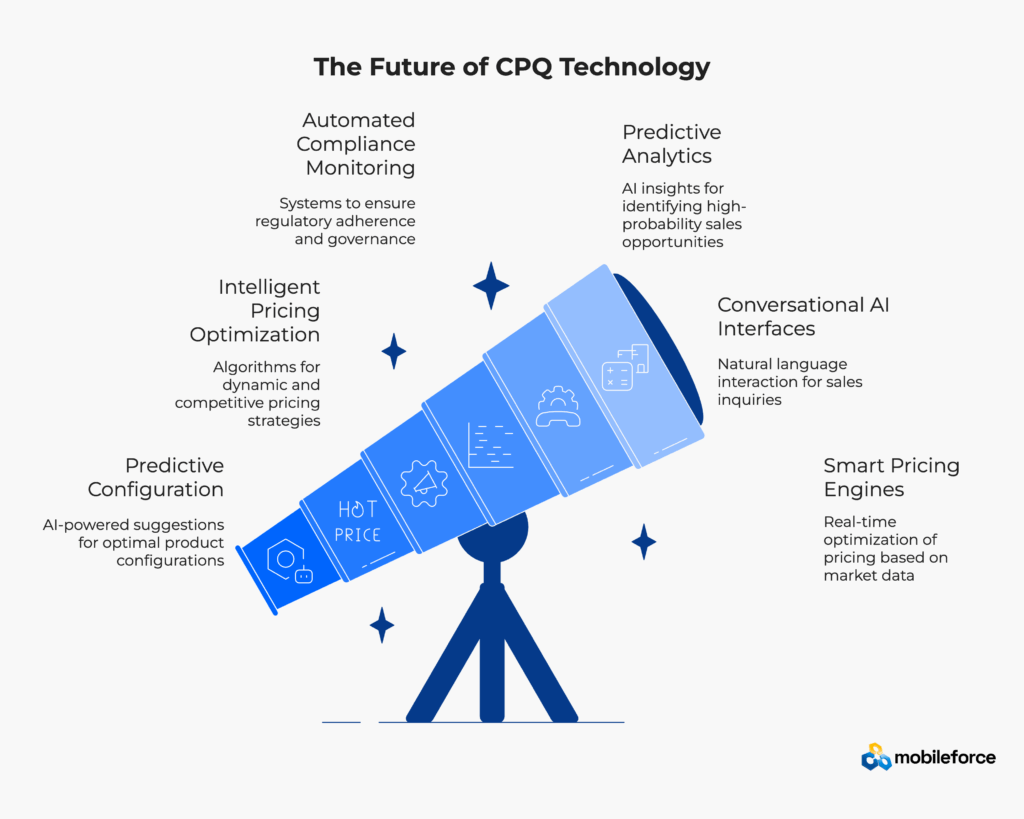
The evolution of CPQ technology continues to accelerate, with artificial intelligence and machine learning capabilities becoming increasingly integrated into no-code platforms. This convergence promises to deliver even greater value by combining human business expertise with computational intelligence.
Future CPQ platforms will leverage historical data and machine learning algorithms to predict optimal product configurations based on customer characteristics, industry requirements, and competitive dynamics. Rather than requiring sales representatives to manually evaluate thousands of possible combinations, AI-powered systems will present the most relevant options while explaining the reasoning behind recommendations.
This predictive capability will prove particularly valuable for complex B2B sales where product configurations involve multiple interdependent variables. Sales representatives will benefit from AI assistance while maintaining full control over final recommendations and pricing decisions.
Pricing represents one of the most challenging aspects of B2B sales, requiring balance between competitiveness, profitability, and strategic objectives. Future no-code CPQ platforms will incorporate sophisticated pricing algorithms that consider market conditions, competitive intelligence, customer history, and deal characteristics to recommend optimal pricing strategies.
These capabilities will enable organizations to implement dynamic pricing models that respond automatically to market changes while maintaining governance controls and approval workflows for significant deviations from standard policies.
Regulatory compliance and corporate governance requirements continue to increase in complexity across most industries. Future CPQ platforms will incorporate automated compliance monitoring that flags potential issues before quotes are generated and provides guidance for resolution.
This automated monitoring will prove particularly valuable for organizations operating across multiple jurisdictions with different regulatory requirements, tax policies, and business practices.
AI-powered CPQ solutions will enable predictive analytics that help sales teams identify the highest probability opportunities and optimize their time allocation. Machine learning algorithms will analyze customer behavior patterns to suggest the most effective engagement strategies and product recommendations.
Next-generation CPQ platforms will feature conversational AI interfaces that enable natural language interaction for product configuration and pricing inquiries. Sales representatives will be able to describe customer requirements in plain language and receive intelligent product and pricing suggestions based on the platform’s understanding of business rules and market conditions.
Smart pricing engines within future CPQ systems will continuously optimize pricing strategies based on real-time market data, competitive intelligence, and customer behavior analytics. These systems will help organizations maintain pricing competitiveness while maximizing profitability across different customer segments and market conditions.
Stay ahead of these trends with a platform built for the future—explore Mobileforce.ai’s roadmap and discover how AI-enhanced CPQ capabilities can benefit your organization today and tomorrow.
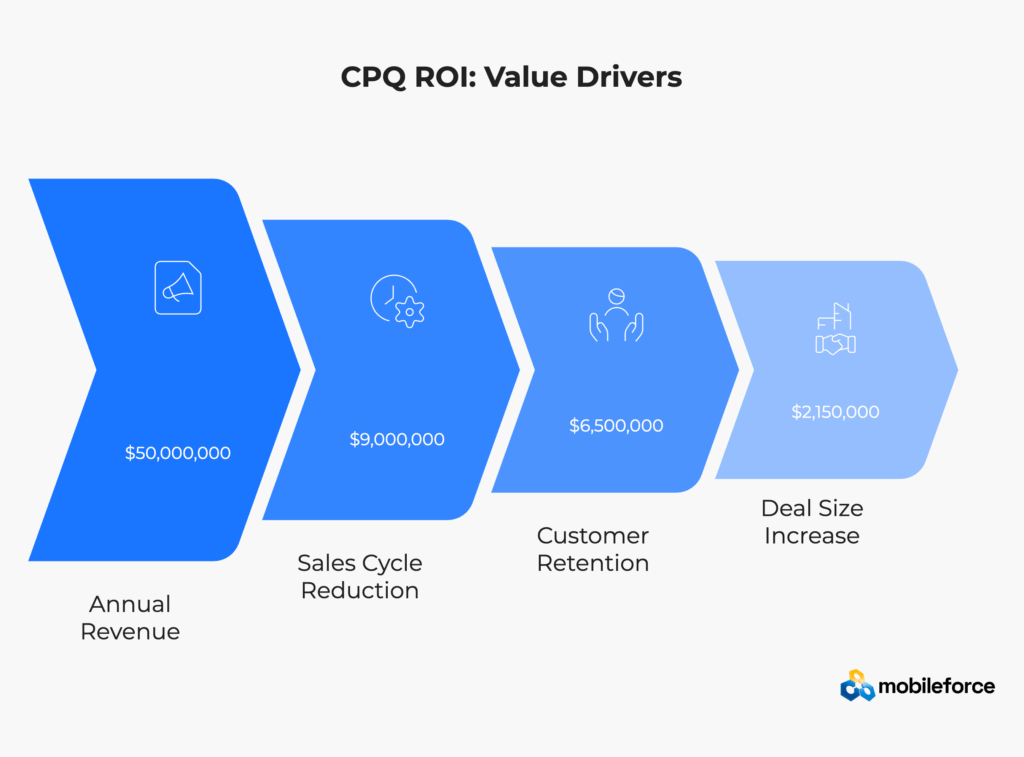
Organizations evaluating CPQ alternatives need clear frameworks for quantifying potential returns on investment. No-code platforms offer multiple value drivers that, when properly measured, typically demonstrate compelling business cases even for conservative assumptions.
The most straightforward ROI calculation compares implementation and ongoing operational costs between traditional and no-code approaches. Traditional CPQ implementations typically require $200,000-$500,000 in upfront costs plus $100,000-$300,000 annually for maintenance and updates. No-code platforms often reduce these costs by 60-80% while delivering comparable functionality.
But direct cost savings represent only part of the value equation. The speed and agility advantages of no-code platforms create revenue opportunities that may exceed cost savings in total impact.
Faster quote generation directly impacts sales cycle length and deal closure rates. Aberdeen Group research indicates that organizations with optimized quoting processes close deals 18% faster and achieve 23% higher win rates compared to those using manual or legacy automated processes.
For a sales organization generating $50 million annually, an 18% reduction in sales cycle length could increase revenue by $9 million per year simply by enabling more deals to close within each reporting period. According to Aberdeen Group’s latest findings, Best-in-Class CPQ users demonstrated customer retention rates 13% higher than industry average, along with 4.3% greater average deal size increases year-over-year. When combined with higher win rates, the revenue impact often exceeds total CPQ platform costs within the first year of implementation.
Sales representatives using effective CPQ platforms can handle larger territories, pursue more opportunities, and spend more time on high-value selling activities rather than administrative tasks. These productivity improvements typically translate to revenue increases without proportional headcount growth.
The cumulative effect of these value drivers creates compelling ROI scenarios that justify no-code CPQ investments across a wide range of organization sizes and industries.
CPQ ROI calculation should include factors such as reduced quote turnaround time, improved pricing accuracy, decreased sales cycle length, and enhanced customer satisfaction scores. Organizations implementing modern CPQ solutions often see payback periods of 6-12 months based on operational efficiency gains alone.
Sales cycle optimization through automated quoting and pricing tools enables sales teams to pursue more opportunities and close deals faster. The resulting improvements in sales velocity and deal conversion rates contribute significantly to overall revenue growth and competitive positioning.
Quote-to-cash efficiency improvements from CPQ implementation typically include reduced manual effort, fewer pricing errors, faster approval processes, and improved visibility into deal progression and pipeline health.
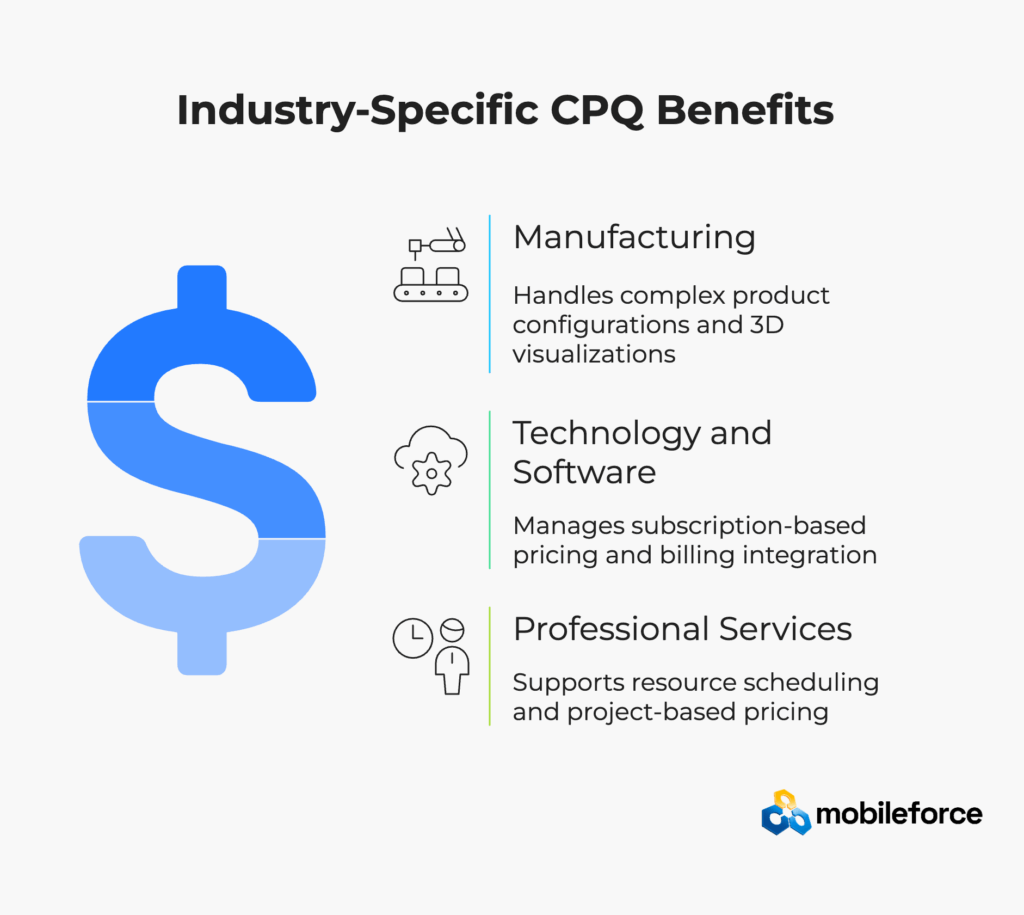
Different industries face unique challenges that influence CPQ platform selection and implementation approaches. Understanding these industry-specific requirements helps organizations identify the most relevant capabilities and avoid platforms that may excel generally but fall short for specialized needs.
Manufacturing organizations often deal with highly configurable products, complex bill-of-materials structures, and integration requirements with ERP and PLM systems. No-code CPQ platforms serving manufacturing customers need sophisticated product configuration engines that can handle engineering constraints, inventory availability, and manufacturing lead times.
The ability to visualize product configurations becomes particularly important for manufacturers selling customizable equipment or systems. Advanced no-code platforms provide 3D visualization capabilities that help sales representatives and customers understand exactly what they’re purchasing.
Technology companies frequently offer subscription-based pricing models, usage-based billing, and complex licensing structures that challenge traditional CPQ approaches. No-code platforms serving this market need flexible pricing engines that can handle recurring revenue models, usage calculations, and multi-year contract scenarios.
Integration with billing and revenue recognition systems becomes critical for technology companies that need to maintain compliance with accounting standards while optimizing pricing strategies.
Services organizations face unique challenges around resource scheduling, skill matching, and project-based pricing that differ significantly from product-focused industries. CPQ platforms for services need capabilities around resource planning, time-based pricing, and project profitability analysis.
The ability to integrate with project management and resource planning systems enables services organizations to provide accurate delivery timelines and pricing while maintaining visibility into resource utilization and project profitability.
Manufacturing CPQ solutions must support complex product hierarchies, engineering-to-order processes, and integration with CAD systems for accurate bill-of-materials generation. These specialized requirements often favor platforms that offer industry-specific functionality over generic quoting tools.
B2B CPQ platforms serving complex industries need robust product catalog management, sophisticated pricing rule engines, and seamless integration with backend systems including ERP, inventory management, and financial applications.
Enterprise sales organizations across industries benefit from CPQ solutions that support multi-location deployments, global pricing strategies, and compliance with international regulatory requirements while maintaining centralized governance and reporting capabilities.

Enterprise adoption of no-code CPQ platforms requires robust security frameworks and compliance capabilities that meet stringent organizational requirements. Modern platforms address these needs through comprehensive security architectures that often exceed the capabilities of traditional alternatives.
No-code CPQ platforms handle sensitive pricing information, customer data, and competitive intelligence that require careful protection. Enterprise-grade platforms implement multi-layered security controls including encryption at rest and in transit, role-based access controls, and comprehensive audit logging.
The visual nature of no-code interfaces actually enhances security visibility by making it easier to understand who has access to what information and what changes have been made. Traditional systems often bury security configurations in complex technical documentation that makes governance difficult.
Organizations in regulated industries need CPQ platforms that support compliance with standards like SOX, GDPR, HIPAA, and industry-specific requirements. No-code platforms can simplify compliance by providing built-in controls for data handling, approval workflows, and audit trail maintenance.
The ability to quickly modify business processes in response to regulatory changes becomes particularly valuable as compliance requirements continue to evolve across different jurisdictions and industries.
Enterprise security requirements for CPQ platforms include comprehensive data encryption, secure API endpoints, regular security audits, and compliance with industry standards such as SOC 2 Type II and ISO 27001 certifications.
Data governance capabilities within modern CPQ platforms enable organizations to maintain control over sensitive pricing information while providing appropriate access to sales teams and partners. These controls help ensure compliance with corporate policies and regulatory requirements.
Cloud security features in leading CPQ solutions include advanced threat detection, automated backup systems, disaster recovery capabilities, and geographic data residency options to meet specific compliance requirements for different industries and regions.
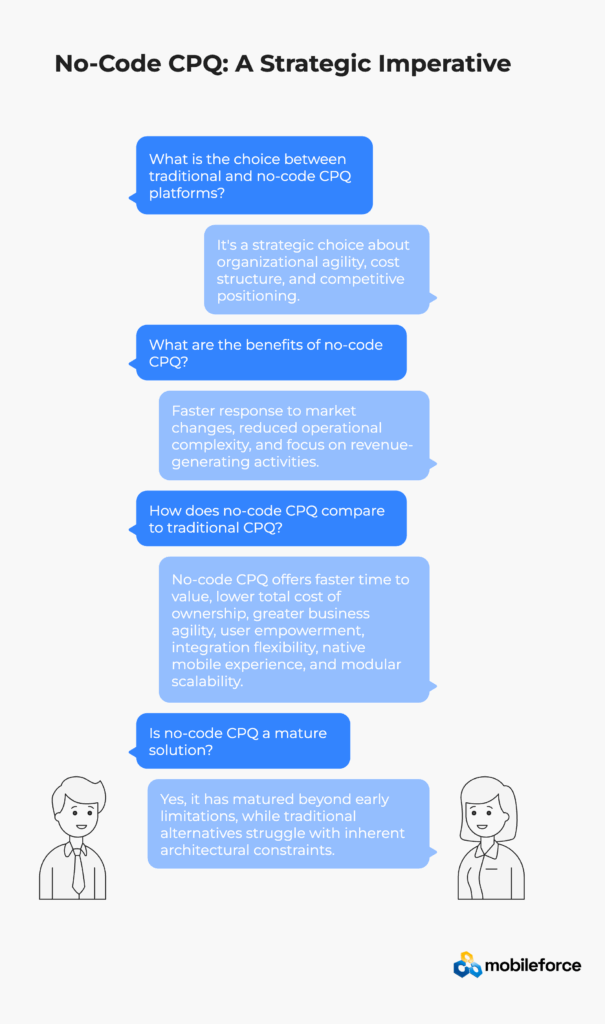
The choice between traditional and no-code CPQ platforms represents more than a technology decision—it’s a strategic choice about organizational agility, cost structure, and competitive positioning. Organizations that embrace no-code approaches position themselves to respond faster to market changes, reduce operational complexity, and focus resources on revenue-generating activities rather than technology maintenance.
Comparison Summary | Traditional CPQ | No-Code CPQ |
Time to Value | 6-12 months | 2-6 weeks |
Total Cost of Ownership | High ongoing IT costs | Low maintenance overhead |
Business Agility | Slow change cycles | Rapid iteration capability |
User Empowerment | IT-dependent | Business user control |
Integration Flexibility | Limited ecosystem | Multi-platform connectivity |
Mobile Enablement | Often constrained | Native mobile experience |
Scalability | Complex and expensive | Modular and efficient |
The evidence overwhelmingly supports no-code approaches for organizations seeking to optimize their quote-to-cash processes while maintaining flexibility for future growth and change. The platforms have matured beyond early limitations while traditional alternatives continue to struggle with inherent architectural constraints.
Ready to make the strategic shift to no-code CPQ? Contact Mobileforce.ai to begin your transformation journey and see how simplicity truly wins in the era of agile selling.
No-code CPQ platforms typically deploy in 2-6 weeks compared to 6-12 months for traditional systems. This dramatic difference stems from the visual configuration approach that eliminates custom coding requirements and extensive technical documentation. Organizations can begin generating quotes within days of initial setup and iteratively refine configurations based on user feedback. The shortened timeline allows businesses to realize value faster and adapt to market changes more quickly.
Modern no-code CPQ platforms support sophisticated pricing models including volume discounts, tiered pricing, multi-currency calculations, complex approval workflows, and dynamic pricing based on market conditions. Advanced rule engines can handle conditional logic that matches or exceeds traditional system capabilities while remaining accessible to business users through visual interfaces. These platforms enable rapid testing and optimization of pricing strategies without requiring development resources.
Enterprise no-code CPQ platforms implement comprehensive security frameworks including encryption, role-based access controls, audit trails, and compliance monitoring. The visual nature of no-code interfaces often enhances security visibility compared to traditional systems where configurations may be buried in technical code. Leading platforms maintain certifications such as SOC 2 Type II, ISO 27001, and industry-specific compliance standards while providing detailed audit logs for governance purposes.
Leading no-code platforms offer pre-built connectors for major CRM, ERP, and business systems along with APIs for custom integrations. Many platforms are designed to be CRM-agnostic, enabling organizations to maintain existing technology investments while adding advanced CPQ capabilities. Integration typically includes bidirectional data synchronization, real-time updates, and support for complex data mapping requirements without custom development.
No-code platforms typically provide native mobile applications with full functionality, while traditional systems often offer limited mobile access or require separate mobile development projects. This mobile-first approach enables field sales teams to generate quotes anywhere without connectivity constraints. Mobile CPQ applications support offline operation, automatic synchronization, and full feature access including product configuration, pricing, and approval workflows.
Enterprise no-code platforms provide multiple extension mechanisms including custom fields, advanced workflow engines, and API access for specialized requirements. Many platforms also offer hybrid approaches where standard functionality remains no-code while specific customizations can be developed when absolutely necessary. This flexibility enables organizations to benefit from no-code simplicity while maintaining access to custom development for unique business requirements.
No-code platforms significantly reduce training requirements through intuitive visual interfaces that align with business processes rather than technical concepts. Most users can become productive within days rather than weeks, and ongoing training focuses on business process optimization rather than technical system administration. The self-service nature of no-code platforms enables business users to make modifications and improvements without extensive technical knowledge.
Total cost of ownership includes initial implementation, ongoing maintenance, user training, system administration, and opportunity costs of slow deployment. No-code platforms typically reduce costs across all categories while enabling faster time-to-value that can impact revenue generation positively. Organizations should consider both direct costs and revenue acceleration benefits when calculating ROI for CPQ investments.
The visual, business-user-controlled nature of no-code platforms enables rapid adaptation to new products, pricing models, and market conditions. Organizations can test new approaches quickly, implement successful changes immediately, and avoid the technical debt that often constrains traditional systems during periods of growth. This agility becomes increasingly valuable as market conditions and customer expectations continue to evolve rapidly.
Key evaluation factors include ease of use for business users, integration ecosystem support, mobile capabilities, scalability architecture, security framework, vendor stability, and total cost of ownership. Organizations should prioritize platforms that align with their specific industry requirements while providing growth flexibility. Proof-of-concept evaluations can help assess platform fit before making final selection decisions.